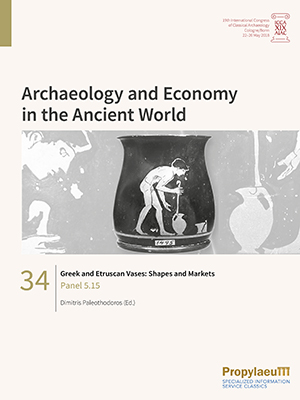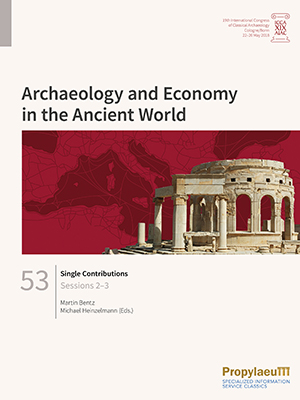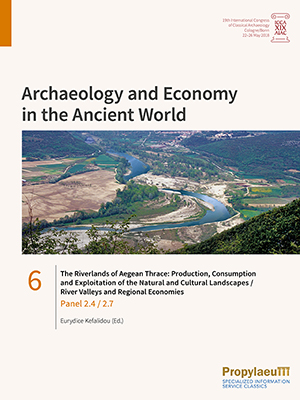Tsiafaki, Despoina
Greek and Etruscan Vases: Shapes and Markets: Panel 5.15
The eight essays published in this volume address topics relating to the production, consumption and trade of painted pottery in the Ancient Mediterranean World, during the Archaic and Classical periods, with special emphasis on the Italian Peninsula, Greece and the Balkans. Important questions on the use, function and role of vases at a broader social or religious level have also been taken into account, by focusing on the response of individual clients to both imports and local vases, or by examining specific shapes traded in both the home market and overseas. Another goal attempted, and to a large extent fulfilled, was to present fresh material, newly excavated or recently studied. Above all, our aim was to present original studies that may be considered valuable contributions in vase scholarship.
Sessions 2–3, Single Contributions
Economic aspects permeate all areas of public and private life in ancient societies, whether in urban development, religion, art, housing, or in death. Research on ancient economies has long played a significant role in ancient history. Increasingly in the last decades, awareness has grown in archaeology that the material culture of ancient societies offers excellent opportunities for studying the structure, performance, and dynamics of ancient economic systems and economic processes. Therefore, the main objective of this congress was to understand economy as a central element of classical societies and to analyse its interaction with ecological, political, social, religious, and cultural backgrounds. The theme of the congress was addressed to all disciplines that deal with Greco-Roman civilization and their neighbouring cultures from the Aegean Bronze Age to the end of Late Antiquity.
In this collective volume, single contributions of sessions 2 and 3 are dealing on the one hand with the investigation of natural environmental factors – climate and landscape – as impacts on the ancient economy, and on the other hand with the exploration of production system. Thematically, the spectrum ranges from the contextualisation of ancient handicrafts, to questions about the production of, for example, decorative metal objects, glass, portrait statues and bricks, to ancient architecture and the associated construction system. The temporal and topographical framework extends from Mycenaean and Archaic Greece, through Iron Age Southern Italy and Hellenistic-Roman Sicily as well as Macedonia, to Imperial Spain and Asia Minor.
The Riverlands of Aegean Thrace: Production, Consumption and Exploitation of the Natural and Cultural Landscapes | River Valleys and Regional Economies: Panel 2.4 | Panel 2.7
Rivers have always been vital supports for economies. They provided water for people and animals, irrigated the land, facilitated communication and trade through small vessels or rafts, aided industrial activities, formed rich hunting grounds for fishermen and hunters, and offered raw materials such as sand, gravel and placer deposits - including even gold. At the same time, the deltas and marshlands of rivers, created an inhospitable environment unsuitable for habitation, especially in periods of flood. Furthermore, rivers connected the sea and the littoral zone with the hinterland, and thus allowed the interaction between the populations which inhabited these areas, often locals and colonists/merchants.
The papers address topics such as the reconfiguration of ancient river routes, the settlement and exploitation patterns that were formed around them, the boundaries of the chora of various cities, towns, villages and farmsteads, and the communication or the tensions between different groups that moved or expanded beyond their original habitation zone due to environmental and/or economic reasons.
Panels 2.4 and 2.7 explore multiple facets of some Central and Eastern Mediterranean riverlands. Panel 2.4 investigates Aegean Thrace, i.e. the Northeastern part of Greece and the European part of Turkey. Panel 2.7 looks at three river valleys in two different areas: Athens and Attica with the Ilissos River; and Northeastern Italy with the rivers that flow in the areas of Verona and Parma.









